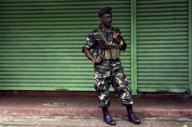 Sri Lanka plans to add at least 50,000 people to its security forces to help control territory won back from Tamil Tiger separatists in the 25-year war that ended in May, the government said on Tuesday.
Sri Lanka plans to add at least 50,000 people to its security forces to help control territory won back from Tamil Tiger separatists in the 25-year war that ended in May, the government said on Tuesday.
The move could further complicate the country’s efforts to get an International Monetary Fund loan seen as an important sign of foreign support and a boost for its economy and markets.
Sri Lanka’s military and police, with a combined strength of 350,000, won one of the Asia’s longest modern wars and declared total victory over the Liberation Tigers of Tamil Eelam (LTTE) and its leaders on May 18.
"We are planning to recruit at least 50,000 for army, navy, air force and police," Keheliya Rambukwella, defence spokesman and a government minister, said in the first security media briefing since the end of the war.
Foreign diplomats have questioned the need for an increased post-war military, already boosted since 2005 to the size needed to finish off the LTTE’s de facto standing army of fighters, replete with artillery, boats and planes.
"We need them to administer the 16,000 sq km (6,178 sq mile) liberated from LTTE control and the two-thirds of the sea area which was under the threat of the LTTE," Rambukwella said.
The plan could be a new drag on Sri Lanka’s efforts to get a $1.9 billion (1.15 billion pound) IMF loan, already delayed in political wrangling with Western nations angry Sri Lanka refused their calls to slow the final offensive and beat back moves to launch international probes into possible war crimes.
Western diplomats say that rather than finance increased security forces, more money should be channelled towards redevelopment and post-war infrastructure building.
Soldiers are currently combing the formerly LTTE-held territory for remnant fighters, buried weapons caches and landmines that need to be cleared before the nearly 300,000 refugees now held in camps can be sent to their homes.
Despite the war’s end, there has been no relaxation of security. Checkpoints and troops are still regular features in the country’s main cities and along its roads.
"Barriers are all over the world and the question is not the barriers, but the terrorism, which we have eradicated," Rambukwella said.
Some tourism operators have warned that the high-security environment could turn off visitors to the Indian Ocean island, which is hoping for a post-war tourism revival.
"We will go on very aggressive marketing campaign and we are targeting 1 million tourists from this winter to next winter," Rambukwella said. Sri Lanka had 438,475 tourist arrivals in 2008.
(For updates you can share with your friends, follow TNN on Facebook and Twitter )
